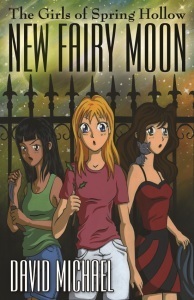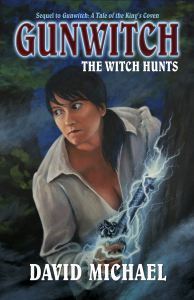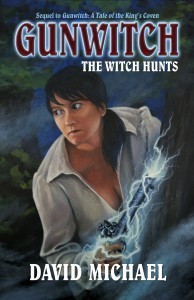David R. Michael's Blog, page 7
April 10, 2013
What Have I Been Doing the Past Month or So?
Writing, mostly. And, this week, taxes. And, also this week, I released an update of The Journal .
GoSH3, whose title is almost certainly to be Red Moon Faire, is now past 40,000 words, which is roughly halfway to The End. I expect to be releasing this one in late summer 2013, just a couple months after the release of GoSH2 (Living Ghost Time), which is out to first readers now. I’m excited about both books. The Girls of Spring Hollow (GoSH) will go from one book to three almost all-at-once.

That’s about it, really.
More news as it happens.
-David
Related Posts:
Little Girl ThrillersA Couple FirstsA Scenic Outlook on the Evolving Road Map
March 11, 2013
A Couple Firsts
The First First: This morning I wrote the first 1100 words of GoSH3 (possible titles are “Three Nights of the Red Moon” or “Red Moon Faire” or something I haven’t thought of yet).
The Second First: This is the first time I’ve ever started writing a sequel before the book that precedes it has been published. Or even read by anyone not me. This might be considered gutsy. Or at least odd. Possibly foolish. My plan, though, is to release both GoSH2 and GoSH3 this summer (2013). Back-to-back publishing like that required back-to-back writing. So it might make sense. Eventually.

-David
Related Posts:
A Scenic Outlook on the Evolving Road MapLittle Girl ThrillersAgain, THE END
February 25, 2013
My Novel Publishing Process
First, I need a completed first draft of the novel. As we have seen, this can take anywhere from 3-4 weeks (The Door to the Sky and The Summoning Fire) to three years (The Girl Who Ran With Horses and Gunwitch: A Tale of the King’s Coven). But, once the first draft is in the can, the rest of the process can go much faster (no fickle, panicky author to deal with; most of the time). Toolbox: Of course, I write my novels in The Journal .
Second, I contact the artist and tell him I need a cover for my new novel. I get this started as soon as possible because it usually takes some time to agree on a concept (sometimes, the artist insists on reading the book first), and then there is the time required to paint the image, and finally layout the text. Fortunately, this can all happen simultaneous with the rest of the process.
Third, after a period of two-four weeks of letting the manuscript “lay fallow”, during which time I’m doing “something else” (whatever that might be), I give the manuscript its first read-through-edit-pass. Specifically, I make a copy of the whole thing, and start reading at the beginning, editing and proofing as I go. This usually takes about a week (not 40 hours of work, just a calendar week). Toolbox: Still using The Journal here.
Fourth, I send my newly edited manuscript to first readers (including the artist). I’m accumulating multiple sets of first readers, based on the novel. First readers for my little girl novels, for example, including my 11-year-old daughter, and a friend who has no interest in the violence/horror of the Rose Bainbridge, Gunwitch novels. In the past, I’ve been a bit loose on the timeframe for my first readers, giving them anywhere from one month to two months to get back to me. Now, though, I’m looking at just four weeks.
Fifth, four weeks later, with the feedback from my first readers handy (which sometimes includes proofing/typos), I do another read-through-edit-pass. Just like before, I make a new copy of the manuscript and apply the changes to that. This takes about a week. Toolbox: The Journal.
Sixth, the tedious part. I do a copy edit, running each chapter of the manuscript through Serenity Software’s Editor . This also takes about a week. Because it’s deadly dull and I have to make myself do it. Toolbox: Serenity Software’s Editor and TextPad (for side-by-side viewing of the Editor output files).
Seventh, I take the now polished and shiny manuscript and begin formatting it for print. I used to do the ebook formatting first, but I’ve learned that doing the print version first is better. Because as I do the formatting, I’m still finding typos and other proofing errors. So I get to update the base manuscript and the print version. Then, when I do the ebook formatting, its a perfect copy of the print version. By now, the cover artwork is usually done. This process takes about a calendar week, as well (which could be because as a project manager I just like to schedule tasks in weeks). Toolbox: Serif PagePlus X4 (print) and StoryBox (ebook formats).
Eighth, I upload the various files to the various distributors. I allow a week for this because I need to get a proof from the printer–and because sometimes you just need extra time to do simple things. Currently, I use CreateSpace for print-on-demand, and upload ebooks to Amazon KDP, Barnes & Noble PubIt, Kobo, and Smashwords. In the near future, I plan to start uploading directly to Apple, as well.
Finally, four weeks after the upload, when everything should be good to go pretty much everywhere, I announce the new novel. OK, yes, this is new-ish. Used to, I announced the new novel pretty much ASAP, but I like this approach better. It’s more festive.

So, from “The End” to “Now Available” should be about 15 weeks.
-David
Related Posts:
Pulling Together the Next ReleaseFound a Useful Editing Tool TodaySlow Motion Progress
February 19, 2013
Again, THE END
The first draft of GoSH2 (sequel to New Fairy Moon) is now complete at 71660 words. Yay!

-David
Related Posts:
A Scenic Outlook on the Evolving Road MapSlow Progress on GoSH2My Longest Outline Ever
February 15, 2013
Little Girl Thrillers
 That’s more or less what I was thinking when I started planning the series, The Girls of Spring Hollow: Little girl thrillers. Or maybe “tween thrillers”.
That’s more or less what I was thinking when I started planning the series, The Girls of Spring Hollow: Little girl thrillers. Or maybe “tween thrillers”.The first book, New Fairy Moon , established the pattern I plan to follow for all the GoSH books. Which is, in summary: The three girls, Faye, Brenna, and Lupe, all of them eleven years old, each of them possessed with unique supernatural gifts, face off against nefarious villains that threaten Spring Hollow, the neighborhood where they live. In keeping with the thriller genre, the stories will take place within a 24- to 36-hour period with a “ticking clock” that keeps the pressure on.
I’m nearing the end of the second book in the series, which I have been calling GoSH2 (New Fairy Moon was GoSH1) but will likely be called Living Ghost Time when I release it this summer, and I’ve started thinking about GoSH3, which I will start writing in March (and will also be released summer 2013). My primary first reader for this series, my own 11-year-old daughter, is already waiting impatiently for me to be finished–with both books.
So far, I’m enjoying the challenge of coming up with stories that fit within my vision of “little girl thrillers”. Not only do the stories need to launch quickly and give all three girls their time in the spotlight, but the stories need to stay well within the boundaries of “Will I let my own little girl read this?” I’m going for intense, thrilling, and maybe even a little bit scary, but with more than a touch of humor throughout.
My current plans are for 6 GoSH books with the current set of girls. Then maybe explore the past of Spring Hollow with another set of books and another three girls. Of course, by the time I get all of those books written, who knows how old my little girl will be? So I better get back to work…

-David
Related Posts:
Now Available – New Fairy MoonA Scenic Outlook on the Evolving Road Map#5 is a First by Being a 2nd
February 9, 2013
The Trackless Sea of Words
I’ve decided to stop tracking my daily word count production. Or, at least, to give not tracking my daily word counts a try in February. (NOTE: I first posted that I was thinking about this in a comment on Camille Laguire’s blog , when she seemed to be thinking along similar lines. Now I’m talking about it here, on my own blog.)
One reason I’m doing this is that the whole exercise of word counting has become more than a bit tedious. Who cares how many words I write on a given day? Or how many days it takes me to get a novel outlined and written to “The End”? All that matters is whether I get the novel or short story done.
Another reason, is that with the shift toward writing being my primary daily work activity, the number of words I should write each day went up. Way up. If you’re only allocating 1 hour per day to writing, then setting the goal of writing 1000 words helps you maximize that time. And tracking that helps you know how well you’re doing. Keeps you focused.
But what if you’re now spending 4 or more hours a day on writing? If you stick with the 1000 words an hour, now you have a 4000 (or more) word quota for the day. Which can be a somewhat intimidating number. And, every morning, you start at 0 and have to work your way up.
4000 words a day is hardly impossible. I’ve even done it before, though only a few times. Back in January 2011, I racked up two consecutive weeks of 15,000 words (on 8 of those days writing 3000 words or more). Hell, my indie buddy Mark Fassett just had a week where he wrote 4500+ words most of the days–and he’s in position to continue that pace indefinitely (which is just amazing). And there’s more than one person out there who has had days of writing 10,000 words or more (though not across a whole week, usually).
Still, I balked. Starting at 0 every day, and knowing that it was going to take hours to hit the daily quota, weighed me down. It was depressing.
So, starting Monday, 28 January, I stopped tracking how many words I wrote on a day. And I made the decision to keep not tracking my daily words through the end of February. I would judge the effectiveness of this approach by how close to “The End” I was in my current project (GoSH2) come the end February.
My hope was that by removing the focus on the daily quota, and getting rid of even the small amount of overhead it took to track my words on a day, that I would “loosen up” again. Avoid the depression. Get the writing done without the “clockwatching” mentality that had set in.
Also, I wanted to make my daily writing more like how I worked on my software projects. When I’m working on a software project, I don’t track lines of code or anything silly like that. Instead, I go through the planned design, working on the current feature until its done, then moving on the next feature. Also, I don’t care how much time I have available. Even if there are just a few minutes available, I can fire up my dev tools and get something done in that time. And I usually end up with 4-5 hours a day spent on the project this way.
This is how I wanted my writing to be. Spontaneous, easy in, easy out, progress inevitable over time. But having to keep track of starting word counts and target word counts and ending word counts, sometimes across multiple chapters, added too much overhead to be spontaneous. I would forego spending a few minutes writing because counting words was just a chore. And I hate chores. I avoid them.
The first week of not tracking (last week) saw some progress, but not as much as I had hoped. Still, the change in mindset, how I view my writing, was under way. I made progress on GoSH2 and on my attitude.
This week just ending (FYI: for my writing, I use a Mon-Sun week), though, was amazing. Monday was a good day versus any day so far this year, and then I did even better on Tuesday. And the week kept improving. Even when I lost mornings to babysitting the toddler or having to run errands, I fired up The Journal and got writing in when I could. Before lunch, after lunch, between handling customer support for The Journal and hunting bugs/adding features to The Journal (because The Journal is still my “day job”). I even found time today, while the baby was sleeping, to knock out some new words.
I’m not entirely sure how much I wrote this week on GoSH2. It’s somewhere just above 12,000 words, I think. Compared to my production throughout 2012 and into January of this year, that’s a lot for a week. And I’m in position (and mindset) to keep this pace going indefinitely. Plus, at this pace, I should be finished with GoSH2 by the first week in March, maybe sooner. Which will be cool.
So, come the end of February, I may not go back to counting words, except at a macro scale (like for a week).
Even if I go back to counting words in more detail, though, (I just added a couple features to The Journal that should reduce the chore aspect) this experiment is already a success. It has helped me get back to where I look forward to writing, and enjoy the process. Which is the important part. Because I have a lot of books left to write.

-David
Related Posts:
I Count WordsRe-ToolingTesting My Limits by Scaring Myself
February 6, 2013
Slow Progress on GoSH2
I’ve been making slow progress on GoSH2, the first sequel to New Fairy Moon . I estimate I’m close to halfway through the first draft. The good news is now that January has finally ended (after significantly changing my and my family’s plans for the year twice), progress should pick up.
In related news, after a bit of research and pondering, I decided to reduce the ebook price for my tween/YA novels. The Girl Who Ran With Horses and New Fairy Moon are now $4.99. I made the change last week, so that price should be active in most online bookstores by now.
So, yeah, I haven’t been doing nothing.

-David
Related Posts:
My Longest Outline Ever#5 is a First by Being a 2ndA Scenic Outlook on the Evolving Road Map
January 28, 2013
Now Available – Gunwitch: The Witch Hunts
The new flintlock fantasy sequel to Gunwitch: A Tale of the King’s Coven is now available!
 A Storm Threatens…
A Storm Threatens…Once a beautiful settlement named for the fabled Fountain of Youth, Founsteeth has become the stronghold of the Three Captains and their pirate crews.
Rose Bainbridge and Janett Laxton arrive in Founsteeth as black stormclouds loom, and as pirates and colonial military officers meet to swap a noble prisoner for a hefty ransom. Rose, a convicted witch and former Gunwitch in the King’s Army, feels almost at home. Young Janett, though, turns heads and more than one of the Three Captains seems to be calculating her possible ransom.
When enemies worse than any pirate strike with the onset of the storm and capture Janett, Rose must head back into the Amerigon wilderness…
A Witch on the Hunt.
Available in trade paperback and ebook formats at Amazon, Barnes & Noble, Apple, Sony, Kobo and more!
Related Posts:
Now Available – Gunwitch: A Tale of the King’s CovenLast of the Mohicans with Zombies!Flintlock Fantasy
January 27, 2013
Gunwitch: The Witch Hunts
 Gunwitch: The Witch Hunts by David Michael
Gunwitch: The Witch Hunts by David MichaelNovel (Rose Bainbridge, Gunwitch Book #2)
A Storm Threatens…
Once a beautiful settlement named for the fabled Fountain of Youth, Founsteeth has become the stronghold of the Three Captains and their pirate crews.
Rose Bainbridge and Janett Laxton arrive in Founsteeth as black stormclouds loom, and as pirates and colonial military officers meet to swap a noble prisoner for a hefty ransom. Rose, a convicted witch and former Gunwitch in the King’s Army, feels almost at home. Young Janett, though, turns heads and more than one of the Three Captains seems to be calculating her possible ransom.
When enemies worse than any pirate strike with the onset of the storm and capture Janett, Rose must head back into the Amerigon wilderness…
A Witch on the Hunt.
Available from Amazon, Barnes & Noble, Kobo, Apple, Smashwords and more!
January 23, 2013
Proof of Proof

More news soon.

-David
Related Posts:
Gunwitch Proof OrderedNumber 5 is Alive!Some Weeks I'm Productive In Spite of Myself



